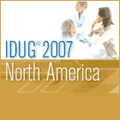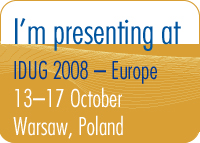 Takeaways from IDUG NA 2007
Takeaways from IDUG NA 2007
Yeah, I know...IDUG wrapped up its 2007 conference a while ago, but I took a bit of a vacation afterward, so I'm just starting to dig myself out of the pile of notes, business cards, and action items that I maneuvered my self into back in San Jose. I'm sharing my observations so those of you who didn't attend the conference can get a feel for what goes on there. Even if you did attend, IDUG is kind of a big conference, with a lot going on at the same time, so maybe I saw a few things that you missed.
The numbers
IDUG staffers with SmithBucklin estimate this year's conference turnout at around 1500 attendees, which beats last year's numbers and this year's initial projections. Surprisingly, quite a few attendees simply showed up the first day and paid full rip at the registration booth, rather than booking just a few weeks in advance and saving several hundred dollars. If those folks waited until the last minute to register, they probably paid top dollar for their airfare and lodging as well. I'm a bit puzzled by that tactic, but perhaps it's because I don't work for a big, indecisive company.
 The surprisingly good keynote
The surprisingly good keynote
After fidgeting my way through much of the pitch-heavy keynote at Monday's kickoff session, I didn't have very high expectations for Wednesday's keynote from Jeff Jonas, a guy I'd never met, whose company made some sort of fraud-detecting software that IBM acquired over two years ago. I couldn't have been more wrong. First and foremost, Jeff was genuinely funny, which made the 90 minutes fly by. His slides were illustrated primarily with monochromatic squiggles that one would assume were drawn by a hyperactive first-grader or perhaps a clever parrot, until he explains that he does his own illustrations mostly during long flights and without the aid of a mouse (as if using a mouse would even help). Despite having a title of Chief Scientist, Jeff was surprisingly humble when he talked about the events that shaped his career, such as the stint where he lived out of his car before forming SRD, and the executives he actively recruited to replace him as CEO and chairman of his own company. Even when Jeff got down to brass tacks about his company's software, it was still thoroughly interesting. He covered a lot of ground in his talk, rarely spending more than a minute per slide, in a bit of a rush to catch a mid-morning flight out of San Jose. Many of my colleagues either couldn't or didn't drag themselves to this early morning session, but I'm glad I did, because it was very well done and a refreshingly unique presentation for IDUG.
An afternoon at Nerdvana
The other highlight that day was a late afternoon reception at SVL, which will soon be comemmorating its 30th anniversary as the world's first large-scale software development lab. Conference attendees who caught the IDUG bus to SVL could mingle amongst themselves, talk to DB2 developers from the Toronto Lab, or follow SVL's big-brained Martians on a guided tour through much of the facility. Among other things, the tour revealed that IBM routinely videotapes users (with permission, of course) in order to improve software usability, and that the average software developer at SVL has a private office with a door (what a good idea). We also saw countless zSeries mainframes, and over a third of a petabyte of high-end storage. It may not be the Googleplex, but our sunny afternoon at SVL was the best off-site reception of the six IDUG conferences I've attended.
Emerging details of Viper II
Just when you thought IBM had unveiled all of their database tricks last year when DB2 9 came out, IBMers from the Toronto Lab are already making careful proclamations about the enhancements in the release they're calling Viper II (which is far less confusing than its original codename of Python). I attended some of those IDUG sessions, as well as the closed beta kickoff for Viper II back in March, and I can safely say that IBM is not content to sit and coast after releasing DB2 9. Viper II contains an impressive mix of enhanced features along with entirely new functionality that aims to profoundly change the way DBAs work with DB2. Unfortunately, I am a bit intimidated by the dense stream of legalese preceding those Viper II slides, so I won't be going into detail about what was discussed in those sessions. The good news is that if you attended the conference (or work with someone who did), you can read all about it on the conference DVD. That way, you get the information straight from the source, and I don't get banned from future DB2 beta briefings, which are typically held in Toronto in the dead of winter.
Little DB2 and Big DB2
For various reasons, many mainframe DB2 shops out there are dipping their toes (or being thrown screaming) into DB2 for LUW, and quite a few of them don't like what they see. That can be evidenced by IDUG sessions that are geared to help perplexed mainframe DBAs navigate the alien world of UNIX, and also by the types of questions and complaints that a few mainframe DBAs raised during open discussions with a panel of DB2 LUW developers from the Toronto Lab. One rather vocal mainframe DBA gave DB2 LUW the snarky nickname of "little DB2" and made a habit of saying it in front of the panelists. To dismiss this person as yet another cranky mainframe bigot would be easy, but unfair. He had legitimate issues with DB2 LUW and suffered significantly more from those problems than he ever did on the mainframe. He also touched on the culture clash between old-guard mainframe administrators (JCL-wielding beardos in suspenders) and UNIX admins (Slashdot-worshipping reboot monkeys). The stories from the mainframers in the room made it loud and clear that in many large corporations, mainframes and LUW systems are butting up against each other like tectonic plates, with similar consequences. It's also happening faster than either mainframers or IBM are ready to handle. Imagine being a mainframe DBA who must migrate a DB2 z/OS application over to an DB2 on AIX, only to find that after decades of co-existing, there are still fundamental discrepancies between their SQL instruction sets. I see similar frustration on the other side, with UNIX DBAs who are sincerely interested in learning more about the mainframe, but are unable to find decent transitional guides that offer a basic introduction to mainframe concepts or zSeries architecture. Rather than being annoyed by the mainframe bellyaching in a DB2 LUW session, I was encouraged when I recognized it as an instance of the two tribes coming together, and the improved software and documentation that will hopefully come from it.
This is actually just a minor portion of what I took away from IDUG, so if you're not sure if IDUG is worth attending, I hope you'll realize just how much valuable material is packed into just a few days each year.
Labels: idug, svl, viper
 IDUG website: Become an IDUG Volunteer
IDUG website: Become an IDUG Volunteer Takeaways from IDUG NA 2007
Takeaways from IDUG NA 2007 The surprisingly good keynote
The surprisingly good keynote DB2 Magazine:
DB2 Magazine:  Dispatches from the IDUG conference
Dispatches from the IDUG conference CODiE Website:
CODiE Website: 

